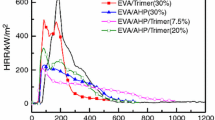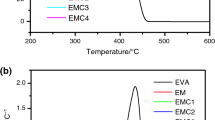Abstract
Model polymer poly(vinyl acetate) (PVAc) was combined with melamine isocyanurate (MIC) as intumescent flame retardant composite. This work emphasises on the study of the decomposition mechanism and compared with a single fire test in order to show its performance as flame retarded composite. As such, mass loss cone calorimetry tests were performed and compared with it inert and oxidative decompositions in lab tests. PVAc/MIC composites cannot be ignited with high loadings MIC. Difference curves in oxidative conditions revealed that the composites with MIC show only positive differences, indicating a high stabilisation, especially in the temperature region of a mild flame (500–700 °C). Experiments performed with TG coupled with mass spectroscopy and analyses on partially degraded residues with solid-state 13C-NMR enabled the construction of the complete decomposition mechanism. MIC has both a heat-sink FR activity as well as a crosslinking role in the stabilization of the polymer. The latter then creates a highly stabilised char at elevated temperatures in oxidative environments. The formed char starts to degrade only 100 °C higher than the pure polymer within a heating. The degradation of formed char of pure PVAc is autocatalytic; this behaviour disappears upon addition of sufficient amount of MIC. Therefore, the transport of fuel towards the gaseous phase is limited, creating an efficient flame retardant system.













Similar content being viewed by others
References
Troitzsch J, editor. plastics flammability handbook. 3rd ed. Munich: Carl Hanser; 2003.
Bugajny M, Le Bras M, Bourbigot S. Thermoplastic polyurethanes as carbonization agents in intumescent blends. Part 2: thermal behavior of polypropylene/thermoplastic polyurethane/ammonium polyphosphate blends. J Fire Sci. 2000;18:7–27.
Bourbigot S, Le Bras M, Duquesne S, Rochery M. Recent advances for intumescent polymers. Macromol Mater Eng. 2004;289:499–511.
Giraud S, Bourbigot S, Rochery M, Vroman I, Tighzert L, Delobel R, Poutch F. Flame retarded polyurea with microencapsulated ammonium phosphate for textile coating. Polym Degrad Stabil. 2005;88:106–13.
Levchik SV, Weil ED. Flame retardancy of thermoplastic polyesters—a review of the recent literature. Polym Int. 2005;54:981–98.
Wang JQ, Chow WK. A brief review on fire retardants for polymeric foams. J Appl Polym Sci. 2005;97:366–76.
Liang H, Asif A, Shi W. Photopolymerization and thermal behavior of phosphate diacrylate and triacrylate used as reactive-type flame-retardant monomers in ultraviolet-curable resins. J Appl Polym Sci. 2005;97:185–94.
Flambard X, Bourbigot S, Kozlowski R, Muzyczek M, Mieleniak B, Ferreira M, Vermeulen B, Poutch F. Progress in safety, flame retardant textiles and flexible fire barriers for seats in transportation. Polym Degrad Stabil. 2005;88:98–105.
Bugajny M, Bourbigot S, Le Bras M, Delobel R. The origin and nature of flame retardance in ethylene-vinyl acetate copolymers containing hostaflam AP 750. Polym Int. 1999;48:264–70.
Camino G, Luda PM, Costa L. Developments in intumescent fire-retardant systems—ammonium polyphosphate-poly(ethyleneurea formaldehyde) mixtures. ACS Symp Ser. 1995;599:76–90.
Zaikov GE, Lomakin SM. Ecological issue of polymer flame retardancy. J Appl Polym Sci. 2002;86:2449–62.
Duquesne S, Delobel R, Le Bras M, Camino G. A comparative study of the mechanism of action of ammonium polyphosphate and expandable graphite in polyurethane. Polym Degrad Stabil. 2002;77:333–44.
Chen X, Cai X. Synthesis of poly(diethylenetriamine terephthalamide) and its application as a flame retardant for ABS. J Therm Anal Calorim. 2016;125:313–20.
Zhou X, Ran S, Hu H, Fang Z. Improving flame-retardant efficiency by incorporation of fullerene in styrene–butadiene–styrene block copolymer/aluminum hydroxide composites. J Therm Anal Calorim. 2016;125:199–204.
Xiao X, Hu S, Zhai J, Chen T, Mai Y. Thermal properties and combustion behaviors of flame-retarded glass fiber-reinforced polyamide 6 with piperazine pyrophosphate and aluminum hypophosphite. J Therm Anal Calorim. 2016;125:175–85.
Rimez B, Rahier H, Van Assche G, Artoos T, Biesemans M, Van Mele B, Rimez HG. The thermal degradation of poly(vinyl acetate) and poly(ethylene-co-vinyl acetate). Part I: experimental study of the degradation mechanisms. Polym Degrad Stabil. 2008;93:800–10.
Rimez B, Rahier H, Van Assche G, Artoos T, Van Mele B. The thermal degradation of poly(vinyl acetate) and poly(ethylene-co-vinyl acetate), Part II: Modelling the degradation kinetics. Polym Degrad Stabil. 2008;93:1222–30.
Mosnacek J, Basfar A, Shukri T, Bahattab M. Poly(ethylene vinyl acetate) (EVA)/low density polyethylene (LDPE)/ammonium polyphosphate (APP) composites cross-linked by dicumyl peroxide for wire and cable applications. Polym J. 2008;40:460–4.
Simon P. Polymer degradation by elimination of small molecules. Angew Makromol Chem. 1994;216:187–203.
Riva A, Camino G, Fomperie L, Amigouët P. Fire retardant mechanism in intumescent ethylene vinyl acetate compositions. Polym Degrad Stabil. 2003;82:341–6.
Zanetti M, Camino G, Thomann R, Mülhaupt R. Synthesis and thermal behaviour of layered silicate–EVA nanocomposites. Polymer. 2001;42:4501–7.
Bourbigot S, Turf T, Bellayer S, Duquesne S. Polyhedral oligomeric silsesquioxane as flame retardant for thermoplastic polyurethane. Polym Degrad Stabil. 2009;94:1230–7.
Gijsman P, Steenbakkers R, Fürst C, Kersjes J. Differences in the flame retardant mechanism of melamine cyanurate in polyamide 6 and polyamide 66. Polym Degrad Stabil. 2002;78:219–24.
Weil ED, Levchik S. A review of current flame retardant systems for epoxy resins. J Fire Sci. 2004;22:251–65.
Wu K, Wang Z, Hu Y. Microencapsulated ammonium polyphosphate with urea–melamine–formaldehyde shell: preparation, characterization, and its flame retardance in polypropylene. Polym Adv Technol. 2008;19:1118–25.
Zhang M, Zhang J, Chen S, Zhou Y. Synthesis and fire properties of rigid polyurethane foams made from a polyol derived from melamine and cardanol. Polym Degrad Stabil. 2014;110:27–34.
Yang W, Lu H, Tai Q, Qiao Z, Hu Y, Song L, Yuen R. You have full text access to this contentFlame retardancy mechanisms of poly(1,4-butylene terephthalate) containing microencapsulated ammonium polyphosphate and melamine cyanurate. Polym Adv Technol. 2011;22:2136–44.
Lim W, Mariatti M, Chow W, Mar K. Effect of intumescent ammonium polyphosphate (APP) and melamine cyanurate (MC) on the properties of epoxy/glass fiber composites. Compos B Eng. 2012;43:124–8.
Rimez B, Rahier H, Biesemans M, Bourbigot S, Van Mele B. Flame retardancy and degradation mechanism of poly(vinyl acetate) in combination with intumescent flame retardants: I. Ammonium poly(phosphate). Polym Degrad Stabil. 2015;121:321–30.
Checchin M, Cecchini C, Cellarosi B, Sam FO. Use of cone calorimeter for evaluating fire performances of polyurethane foams. Polym Degrad Stabil. 1999;64:573–6.
Jash P, Wilkie CA. Effects of surfactants on the thermal and fire properties of poly(methyl methacrylate)/clay nanocomposites. Polym Degrad Stabil. 2005;88:401–6.
Acknowledgements
The company TA Instruments Ltd is kindly acknowledged for the use of the TG–MS equipment.
Author information
Authors and Affiliations
Corresponding author
Rights and permissions
About this article
Cite this article
Rimez, B., Rahier, H., Biesemans, M. et al. Modelled decomposition mechanism of flame retarded poly(vinyl acetate) by melamine isocyanurate. J Therm Anal Calorim 127, 2315–2324 (2017). https://doi.org/10.1007/s10973-016-5783-1
Received:
Accepted:
Published:
Issue Date:
DOI: https://doi.org/10.1007/s10973-016-5783-1




